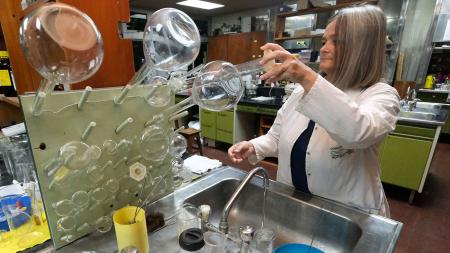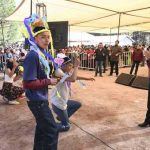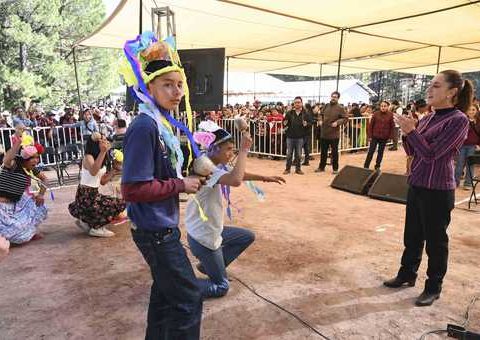Biodiversity research for medicinal purposes transcends the walls of a laboratory and has two key moments, at least in Northeast Argentina. One: listening to the native peoples who are, ultimately, the first source of consultation. Two: field work, whose survey of species is only possible through an interdisciplinary team; Specialists in pharmacy, biochemistry, and botany participate.
In the provinces of the NEA there are different research projects that seek to exploit biodiversity at the service of health. Either from public laboratories or with the support of universities, Missions, Corrientes and Chaco they face field activities, screening, in vitro and in vivo tests, and everything related to the scientific process of pharmacobotany. From the study of an antivenom to the development of a long-lasting repellent.
In the case of Corrientes, Ana María Torres, director of the Laboratory of Natural Producers (LabProdNat) of the Faculty of Exact Sciences of the National University of the Northeast (Unne), coordinates several lines of work, the most advanced being the development of a plant extract with inhibitory activity against the venom of the snake called yarará. The results were published last year in the Journal of Ethnopharmacology.

After in vitro and in silico tests (computer simulation) the researchers discovered which are the compounds responsible for the alexiteric (antivenoin) activity of yellow laurel or Nectandra angustifolia. “In the native peoples, there is evidence of the use of plants when ophidian accidents occur, generally in the form of an infusion or poultice. Plants that counteract the action of a poison are called alexiteric, so with this information we began to see what plants were in the region, together with the Northeast Institute of Botany (Ibone) for correct identification and herbarium storage.” , explains Torres in dialogue with Télam-Confiar.
And he continues: “We have worked over the years with some 20 species. The ones we have studied the most and with the best response are Nectandra angustifolia or yellow laurel, and Cissampelos pareira, which is a creeper. With them we have prepared extracts and carried out in vitro tests, that is, in the laboratory and also in vivo, in mice, as a local treatment”.
Snake venom is composed of complex substances, mainly proteins, with enzymatic activity. These enzymes are responsible for the local and systemic effects causing the following symptoms in the bitten person: swelling, hemorrhage, blisters, bruises and necrosis.

“We have advanced the studies, coming to formulate a gel with the Cissampelos pareira species, which has been tested in vivo in mice as a local treatment with very good results (joint work with the Faculty of Veterinary Medicine of Unne). EITHEROther species currently studied are: Baccharis articulata or carqueja, Croton urucurana or sangre de drago”, Plantago tomentosa or llantén”, details the doctor in Chemistry and also a teacher at the Corrientes house of studies.
“We have been working on the antivenom line for fifteen years, and three years ago we started other lines of research, focused on hypoglycemic and anti-inflammatory plants with the help of the Biochemical Research Laboratory (Libim), of the Unne Faculty of Medicine”, highlights Torres.
“We have an intern who is working with the plant Phyllanthus niruri which is the stonebreaker, where we have already been doing in vivo tests in rats to see if we can reduce postprandial blood glucose, which would be a great finding for patients with type 2 diabetes. So far the results are going well”, anticipated the director of LabProdNat, whose laboratory Like the other research groups involved, they belong to the Institute of Basic and Applied Chemistry of the Argentine Northeast (Iquiba-NEA), double dependency institute, Unne and Conicet.
Repellents with native plants as raw material

In Missionsthe recently opened BioLab dependent on the Province Government Innovation AgencyHe is running a project on the formulation of insect repellents based on native plants. The following are the objects of study: pee grass or petiveria alliacea and cordia curassavica. The academic proposal becomes relevant in a context where vectors threaten the quality of life. Just to mention one example: Aedes aegypti transmits dengue fever – in addition to chikungunya, Zika and yellow fever – unleashing several outbreaks over the years.
Carlos Altamirano, PhD in Pharmacy and professor of the Pharmacobotany chair of the Faculty of Exact, Chemical and Natural Sciences of the National University of Misiones (Unam) he leads the work that began in 2021 and has already entered its last stage.
In the investigation, they alternative and innovative repellent formulations, using as a source of raw material, extracts and essences obtained from plant species of the reddish terroir. So that after the selection and collection of plants with potential repellent activity in the autochthonous flora, extracts and essential oils are made to characterize them chemically.

“There are products installed on the market, such as citronella; so our idea would be to try to obtain some equivalent of our flora that could have an activity similar to or superior to citronella. We are also looking to change the duration time, currently the duration of pesticides is two hours. Let’s suppose an excursion in the mountains or people who work in rural areas, two hours is a very short time”, Altamirano develops.
“We studied two promising plants, the pee or petiveria alliacea, which the Mbya told us that they use it to avoid mosquito bites by rubbing their skin. The other is cordia curassavica, it started with a thesis with interesting results and from there we resumed”, says the author of the research while clarifying “what I propose is to make formulations with a hybrid, with oil and make an extract, extracting all the possible from the plant.
“We have the chemical profiles, we are going to make the formulations and we must make a vivarium, that is, a small cage where we will keep the flying insects and we can carry out the tests”, he comments.
“Another point that will be key this year is the issue of toxicity. Although the topical route offers greater protection, we have to know if it is not toxic and that must be proven. We are going to work with another chair of the Bachelor’s Degree in Genetics, they are thesis specialists in genotoxic analysis ”, he details.
The repellent project is the result of that interaction between Altamirano and the native peoples for an activity already in progress, given that it is the Guarani who produce the plants – ambay, carqueja, cangorosa – that the BioLab uses to make the extracts that are sent to the Misiones Laboratory of Medicinal Specialties (LEMis) for the manufacture of phytomedicines. “They set up a cooperative where they dry and grind the plants, and also sell to other provinces; in those interviews, chatting with them, what they use came up,” he recalls.
The researcher highlights in his arguments that the results obtained will be of educational contributions and may be used for the development of quality pharmaceutical products and in this line he acknowledges the support of his mentors, Felipa Sánchez and Dr. Marta Yajía.

Chaco herbarium with international seal
He Herbarium of the National University of the Austral Chaco called “Engineer Carlos Chifa”has been operating since September 2021 and has the distinction of being the first in the province to be registered in the New York Botanical Garden, one of the largest in the world.
Currently, it has more than 6,500 species and the number is increasing. “The herbarium is a continuation of the professor, engineer Carlos Chifa, who is already retired. He began to collect plants with medicinal uses, most of them native to Chaco, to teach his students botany. He used a classic technique, a drying that is carried out on the specimens and they are mounted on a specific sheet and with the help of chemical compounds it is captured and preserved over time. There are specimens that are 30 years old and are not attacked by insects or bacteria,” says Télam-Confiar, the project manager, the pharmacist, javier rodriguez.

In this sense, he points out: “with the construction of a new building at the University we recovered those collections and began to work to increase the number of copies.”
“The methodology to exclusively select plants with medicinal uses is through surveys of the native peoples or the rural population, mostly from the north of Chaco. Medicine with plants is daily in some areas due to the distance from urban places or health centers ”, he explains.

Cedrón, mburucuyá, ambay These are some of the plants for medicinal purposes revealed by the academics in their visits to the communities. The herbarium’s function is, on the one hand, to guard and protect biodiversity, and, on the other, to prove the identity of the plants by subjecting them to different technical processes.
As an example, Rodríguez argues how the herbarium plays a key role in a line of research, since it allows them to store the sample of the species: “Conicet researchers who work with medicinal plants, specifically Carola Torres and Cristina Pérez Zamora work with the cactus family, and carry out the characterization of the extracts and identification of the active principles. They place the concentrations against bacteria and viruses and then it is reported through scientific publications ”.


















